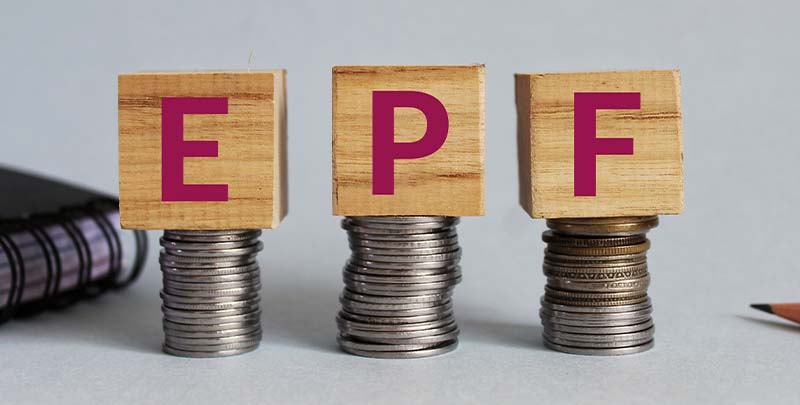EPF contribution is a key component of financial planning, designed to help employees secure their future through a government-mandated savings and retirement scheme. The EPF contribution rate can help build a substantial corpus over time by ensuring regular contributions from employees and employers. Whether preparing for retirement or addressing unforeseen financial needs, understanding how these contributions are calculated and utilised empowers you to make better financial decisions.
What is meant by EPF contribution?
The Employee Provident Fund (EPF) is a government-managed savings scheme to help employees secure their financial future. Mandated by the Employees' Provident Fund and Miscellaneous Provisions Act, 1952, it applies to organisations with 20 or more employees. The employee and the employer contribute to the EPF account monthly, helping build a financial corpus for the employee’s retirement or other approved withdrawals.
EPF contribution by you vs your employer
- Employee’s contribution: The entire 12% goes into the EPF Account.
- Employer’s contribution:
- 3.67% of the employee's basic salary goes to the EPF Account.
- 8.33% goes to the EPS (Employee Pension Scheme), which is capped at a salary of ₹15,000 (a maximum of ₹1,250 monthly).
In addition to these, employers also contribute towards administrative charges:
- 0.5% towards EDLI (Employee Deposit-Linked Insurance).
- 1.1% for EPF administrative charges.
- 0.01% for EDLI administration.
This means the total effective employer contribution is 13.61% of the employee’s salary.
How to calculate EPF contribution?
Here’s an example to illustrate:
- Basic salary + DA: ₹25,000
- Employee's contribution (12% of ₹25,000): ₹3,000
- Employer's contribution (12% of ₹25,000): ₹3,000
- ₹916.67 (3.67% of ₹25,000) is deposited into the EPF Account.
- ₹2,083.33 (8.33% of ₹25,000, capped at ₹1,250 for ₹15,000 salary) is contributed to EPS.
Monthly total contribution (employee + employer): ₹6,000.
To simplify calculations, you can use Axis Bank’s EPF Calculator, which helps determine your retirement corpus based on monthly contributions and accrued interest.
Details required to determine the EPF contribution rate
1. Basic salary and dearness allowance (DA): Up to ₹15,000 for EPS contributions.
2. Employee contribution percentage: Standard rate is 12%; reduced to 10% for specific cases like smaller organisations.
3. Employer contribution rate: 12%, with a breakdown for EPF and EPS.
4. Employee's current EPF balance: Essential for year-on-year interest calculations.
5. Age and retirement period: Determines the interest accumulation period.
Benefits of EPF contribution
1. Tax savings:
- Contributions up to ₹1.5 lakh annually are eligible for tax deduction under Section 80C.
- Interest earned and maturity proceeds are tax-free (under specific conditions).
2. Long-term savings: Ensures financial independence post-retirement, creating a significant corpus over time.
3. Insurance cover: Contributions include EDLI, which provides Life Insurance coverage up to ₹7 lakh.
4. Loan facility: Employees can withdraw partial amounts for emergencies such as medical treatment, education, or home purchase.
5. Pension benefits: Contributions towards EPS ensure a steady pension post-retirement.
Also Read: How to find PF number?
Conclusion
EPF contributions are more than just a statutory obligation — they are essential for financial planning, ensuring long-term savings, tax benefits, and insurance coverage.
FAQs
How much is an EPF contribution?
EPF contribution rate includes 12% of the employee’s salary from both the employee and employer sides. The employer’s share is divided into 3.67% for EPF and 8.33% for EPS.
Is employer contribution to PF 12% or 13%?
While the primary contribution is 12%, additional charges like EDLI and administrative fees bring the effective contribution to 13.61%.
Can I reduce my PF contribution?
Yes, the employee contribution rate can be reduced to 10% for specific cases, such as small organisations with less than 20 employees.
Disclaimer: This article is for information purpose only. The views expressed in this article are personal and do not necessarily constitute the views of Axis Bank Ltd. and its employees. Axis Bank Ltd. and/or the author shall not be responsible for any direct / indirect loss or liability incurred by the reader for taking any financial decisions based on the contents and information. Please consult your financial advisor before making any financial decision.







